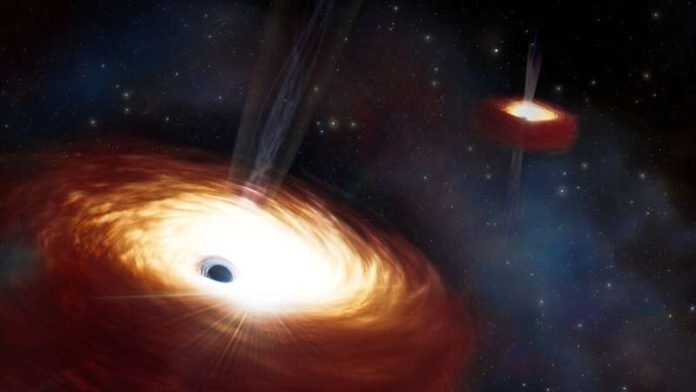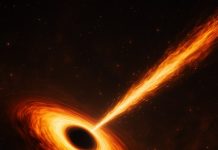
In the vastness of space, using data from the Gemini North telescope, astronomers have discovered the heaviest pair of supermassive black holes ever seen.
The concept of two giant black holes merging has been talked about for a long time, but we’ve never actually seen it happen. This discovery gives us hints about why such an event is rare in the universe.
Imagine galaxies as huge cities in space, and at the heart of nearly every large one, there’s a supermassive black hole.
Sometimes, galaxies crash into each other, and when they do, their central black holes can start circling each other in what’s called a binary pair.
Scientists think that eventually, these pairs should merge into one, but no one has ever seen this happen. This puzzle has been on astronomers’ minds for many years.
A team of space scientists recently shared new findings in The Astrophysical Journal, shedding light on this mystery.
They studied a pair of supermassive black holes in a galaxy far away with the help of the Gemini North telescope in Hawai’i, which is part of the International Gemini Observatory.
This particular pair is special because it’s the only one we’ve seen where you can actually make out both black holes separately. They’re about 24 light-years apart, which is really close in space terms, hinting they might merge into something even bigger.
However, they’ve been stuck at this distance for over three billion years, making scientists wonder why they haven’t merged yet.
To figure out what’s going on, the researchers dug into old data from the telescope. They were able to measure how fast stars are moving around the black holes, which told them how massive the black holes are.
They found out that the pair is 28 billion times heavier than our sun, making them the heaviest black hole pair we’ve ever found. This discovery helps us understand more about how these black holes came to be and why they haven’t merged yet.
The way these two black holes got so close to each other is through a series of galaxy crashes. The galaxy they’re in is like a giant made from many smaller galaxies merging together. This process brought the two supermassive black holes together.
Normally, black holes don’t crash directly into each other; they kind of dance around, getting closer with each loop. This dance slows them down until they’re just a hop, skip, and a jump away from merging.
But this particular pair seems to have kicked out all the stuff around them, leaving nothing to slow them down further, which is why they’re stuck.
This situation is unusual because lighter black hole pairs usually have enough stuff around them to pull them together. But since this pair is so heavy, they needed a lot more stuff to slow them down. Now, there’s nothing left to help them merge, leaving them in a cosmic standstill.
What happens next is anyone’s guess. They might stay in this holding pattern forever or eventually merge if something new comes into the mix, like another galaxy merger. However, since their galaxy is already a mix of many galaxies, another merger seems unlikely.
The scientists are excited to keep studying this galaxy to see if there’s any chance the black holes could merge.
If they do, it would create a huge ripple in space, much stronger than anything we’ve seen from smaller black hole mergers. This discovery not only helps us understand more about black holes but also about how galaxies and the universe work.
The research findings can be found in The Astrophysical Journal.
Copyright © 2024 Knowridge Science Report. All rights reserved.



